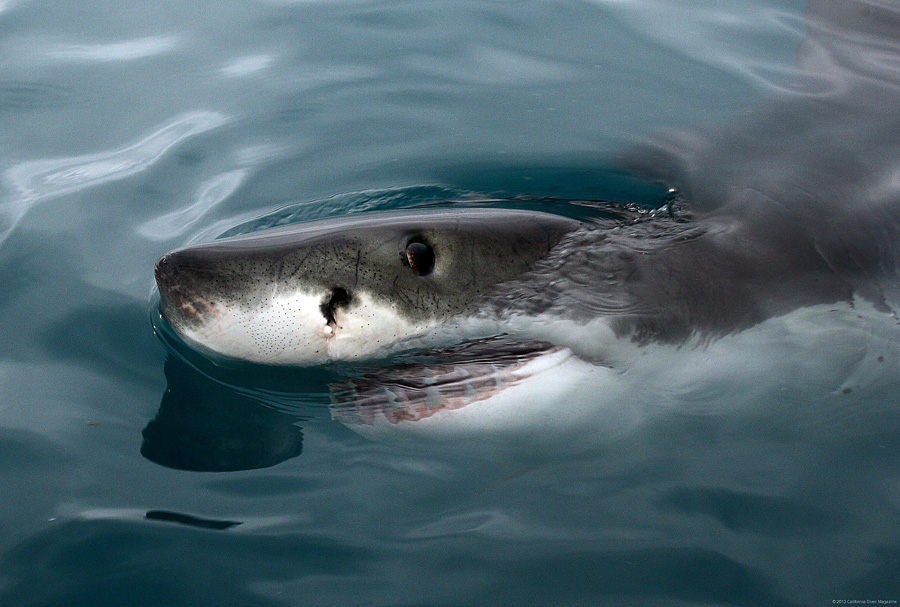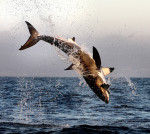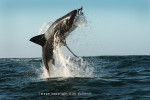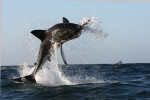Dirk Schmidt developed a passion for sharks from the early age of 10, and by the age of 16 he had compiled his own shark dossier of over 500 pages on apex shark behavior and biology.
Over the years, Dirk’s passion for sharks continued to grow, and since then, he’s written and published 4 nature books including “Surfing the Cape of Storms” in 2008, “Great Whites of False Bay” in 2009 (a world first on breaching White sharks), “The Penguins of Boulders” in 2010 (a book on the endangered African Penguin), and in late 2011, “WHITE SHARKS – magnificent, mysterious, and misunderstood” published by Jonathan Ball Publishers. This latest book includes some of his award winning photographic images, and which has been reviewed on one of South Africa’s premier nature television channel SABC2’s 50/50.
Currently, Dirk is working on a third book on white sharks to include some of his latest findings and current research on white shark behavior, highlighting white shark areas of the USA, Mexico and Australia, and marine conservation issues affecting sharks and rays. Both “Surfing the Cape of Storms” and “The Penguins of Boulders” are expected to be re-published as 2nd editions due to popular demand.
Dirk’s first public foray into television was in 2011, for the Discovery Channel – Shark week program, “How sharks hunt – an anatomy of an attack” (aired August 2011) where he consulted as a on-camera expert concerning white shark attack and predatory behavior. He has held numerous speaking engagements, and his work is recognized having contributed significantly to understanding white shark behavior within the scientific and shark community, developing new insights and understandings in shark behavior and attack profiling by many of his peers. He is a qualified Dive master with over 1,100 dives to his credit, and his motto is: ‘We cannot conserve nor protect something we do not understand.’
I recently had the opportunity to learn more about Dirk and his passion for sharks, and below are the highlights of his background, experience, and lifelong fascination with sharks.
Q: What got you interested in sharks to begin with?
 A: My father took me to see a whaling station when I was about 8, the ferry went right by the whale carcasses, and in the blood stained waters, I could see a several large sharks. Back in the day, a good shark was a dead shark, what interested me though was that the sharks had no interest in anything else but the carcass. It made me start reading and finding out more about these creatures, and soon I had a library of books from Jacques Cousteau, Hans Hass and many others. In 1983 I started diving, and came across large sharks especially around the outer anchorages (off the port of Durban). Most of the sharks encountered where regarded as dreaded “man-eaters” (Tigers, Bulls, Ragged-tooth (Sand Tigers) and Dusky sharks) yet despite their reputation, I found them to be mainly curious, and that my behavior in the water would influence theirs and vice versa. I would roll myself into a small ball and hold my breath, and watch as they came in closer, and see them shy away and keep their distance if I opened my body up and exhaled or started swimming towards them, and so my journey of discovery started.
A: My father took me to see a whaling station when I was about 8, the ferry went right by the whale carcasses, and in the blood stained waters, I could see a several large sharks. Back in the day, a good shark was a dead shark, what interested me though was that the sharks had no interest in anything else but the carcass. It made me start reading and finding out more about these creatures, and soon I had a library of books from Jacques Cousteau, Hans Hass and many others. In 1983 I started diving, and came across large sharks especially around the outer anchorages (off the port of Durban). Most of the sharks encountered where regarded as dreaded “man-eaters” (Tigers, Bulls, Ragged-tooth (Sand Tigers) and Dusky sharks) yet despite their reputation, I found them to be mainly curious, and that my behavior in the water would influence theirs and vice versa. I would roll myself into a small ball and hold my breath, and watch as they came in closer, and see them shy away and keep their distance if I opened my body up and exhaled or started swimming towards them, and so my journey of discovery started.
Q: You have a Ph.D. from the University of Pretoria. What is it in?
A: I actually wanted to study Marine Biology, and had already been approved for an internship with the then Natal Sharks Board, when my late father convinced me to study business instead, which culminated in a Ph.D. in Business Management. In a way it has probably allowed to me more financial freedom to pursue my marine interests, and shark conservation. I actually intend enrolling for a marine biology course in 2014.
Q: You’ve been quoted as saying, ‘You cannot conserve a species you do not understand.’ Sharks, of course, have been greatly misunderstood over the years, with no help from such classic movies as ‘Jaws.’ What do you feel is the most misunderstood aspect of the Great White shark?
A: In my opinion the most misunderstood aspect of Great Whites is their selected diet. These sharks are not the indiscriminate feeders they are made out to be, nor the mindless killers often shown in movies. They are in fact highly selective in their feeding preference, preferring pinnipeds (seals and sea lions), cetaceans (whales, dolphins and porpoises), sharks and rays as well as fish. In fact statistics show that in South Africa, over 80% of all white shark victims survive, and that predatory and/or consumptive attacks on humans are extremely rare.
Q: In recent years, there has been some controversy over the various Great White cage diving operations available for amateur photographers in both South African and the United States. What is your opinion of these? What difference does it make when chum is used to attract the sharks?
A: Firstly, in my opinion, and in the 7 years I spent working on my second book, ‘White Sharks: Magnificent, Mysterious, and Misunderstood,‘ I have not seen many unethical practices in South African shark cage dive operations relating to chumming. The practice of using shark livers by one particular operator has been stopped, and the general shark handling practices near boats has been good. On the issue of chumming using minced fish products, I do not believe it affects nor changes shark behavior as despite the chum being an attractant, no reward is offered to the shark in the for the food. Seal decoys and the odd tuna head is generally used to lure the shark to the surface and to try and keep it interested in the boat. Fishing boats, cleaning their catch, or fishing create a very similar “chum” trail, and fishermen often complain that their catch has been taken by a shark lingering below their boat, hence chumming and attracting sharks to a boat does not materially change the shark behavior. In fact a study conducted by Alison Kock (of Shark Spotters, Cape Town) actually showed a negative connotation of white sharks towards cages, with sharks becoming weary around cages. I have seen this on numerous occasions when large white sharks appear and simply swim by, showing no interest in the cage, bait, decoy or chum whatsoever.
The shark generally has little or no interest in the diver in the cage, being lured closer by proficient shark handlers throwing out their decoys and pulling them in to entice the shark to come closer, the shark shows no aggression towards the caged diver. However from time to time, unethical shark handlers draw the shark directly towards the cage, causing the shark to crash into the cage as it pursues the decoy or bait. This leads to unnecessary contact and harm to the shark and must not be confused with the shark attacking the cage or the diver inside.
Personally I am of the opinion that shark cage diving allows the public and interested individuals to view these sharks safely, and this has changed countless peoples mindsets and opinions towards these magnificent creatures. Cage diving de-mystifies and corrects the demonized status of this species and has helped to not only conserve this creature but also help focus on shark conservation and the need for these creatures in our oceans. The white shark is an iconic species, if people can change their perception or opinions from being a monster or mindless killer, to a very selective apex predator on the top of the marine food chain, they can change their mindset on sharks in general, and this greater awareness leads to greater understanding and ultimately conservation and protection shark species.
Q: There have also been some cases of celebrity ‘shark divers’ swimming with Great White sharks outside the cage for conservation/publicity purposes, in some cases, touching or riding the sharks. What’s your opinion on that?
A: Free diving with White Sharks has done some good in dispelling the “monster” or indiscriminate killer shark image, and shown that these sharks do not deserve their maligned image stereo-typed from movies such as “Jaws”. However having said this, they remain dangerous and very capable apex predators, that will and do attack humans. With the increase of ‘free-diving’ with White sharks, I am increasingly concerned that the day will come where an inexperienced diver will attempt to dive with, try and touch or ride a Great White sharks, for the thrill of it or an ego trip, and be attacked. Diving with these sharks can only be done under very specific conditions and locations, and I fear that sensationalizing such diving events may encourage more people to free-dive with white sharks without sufficient knowledge and understanding of white shark behavior, and how to handle overly “interested” sharks safely.
Q: Recently, in the US, there has been much debate over whether Great Whites need special protection under the law or not, with scientists weighing in on both sides of the issues. In your opinion, do Great Whites merit special protection, and if so, why?
A: The Great White shark is a top apex predator, and therefore its numbers are limited. It is estimated that there are less than 10,000 Great Whites roaming our oceans. Whilst populations such as the Eastern Pacific may be stable, we cannot state the same in the rest of the world. South Africa is renown for its Great Whites, yet latest scientific estimates indicate that less than 1000 individuals roam the Southern African coastline. We understand that these sharks have the ability to migrate over vast oceans, with one recorded transiting from Gansbaai off South Africa to western Australia, and back within again. The protection of the species has already been recognized back in 1998 with its classification under CITES (the Convention on International Trade in Endangered Species of Wild Fauna and Flora), however I would like to see a stronger level of protection with regard to angling, fishing and to some extent research, which allows these large bodied sharks to be hauled out of the water. Experts and renowned scientists and shark biologists have raised concern that removing large White sharks from the water may lead to organ and vessel rupturing resulting in potential mortalities, and I am of the opinion that giving the inherent scarcity of these sharks, that such losses can be ill afforded and removing these sharks from the water, should not be encouraged or supported.
Q: What shark photographing expedition has been the most memorable for you, in recent years?
A: Tough question… every expedition has its highlights, one of my favorite one was sitting on the duck-board between the engines waiting for a breach in rough seas, grey rain-soaked clouds occasionally breaking apart to reveal a glimpse of blue sky, when I captured a rough water breach… but then there was another where I spent over 3 hours in frigid Cape winter waters, and got so cold I could hardly pull the shutter release, but the light and sharks where so good, I could not stop resulting in some awesome underwater shots.
Q: You’ve taken some magnificent photographs of Great White sharks airborne as they prey on seals in South Africa. Can you describe for us how this comes about and why the shark feeds in this manner?
A: Seal Island, located in False Bay, South Africa is unique in many aspects and one of the few locations where White Sharks will regularly breach during predatory events. Seal Island appears to have a specific set of underwater topography that encourages White Sharks to breach in the pursuit of prey. It is not the only place where these sharks breach, and researchers and experts alike have tried to induce breaches at other locations, but none provide the frequency of breaching seen at Seal Island. Predatory breaches, whether on a decoy or on a seal are far from a forgone conclusion, firstly seasonality plays a big part, in that white sharks hunt around the island primarily during the South African winter months, and secondly the time of day plays an important part in whether the sharks will attempt to breach or not, with early mornings and late afternoons recording the highest number of breaches. Crypsis or the ability of the shark to use the dark rocky seabed as camouflage is an important factor, and we have noted as soon as the shark loses the advantage of a surprise or ambush attack due to brightening light conditions, breaching attempts reduce significantly.
Q: What would you say to a young person coming up, who wants to photograph sharks for a living, as you do? What advice do you have for them?
A: Photographing sharks for a living may be challenging, there are many top photographers taking phenomenal shots. My advice would be to start taking images for stock and finding a niche or specific style of photographing sharks. Due to the multitude of shark images available, some creativity and image rareness would be called for that shows the creature in a certain way not commonly seen or performing social or predatory behavioral aspects.
Written by Mike Bear
Photos courtesy of Dirk Schmidt
All content ©2013 California Diver Magazine, and may not be reproduced in any form without prior express written permission.











